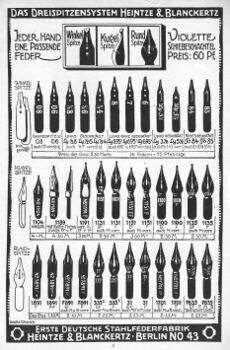Differenze tra le versioni di "Heintze & Blanckertz/en"
| Riga 5: | Riga 5: | ||
Initially the company was based at Heiligegeiststraße 13. Around [[1856]] Blanckertz acquired the property at Fliederstraße 4 in Friedrichshain. Around [[1872]] the property at Gollnowstraße 11 was added and, from 1889, the property at Georgenkirchstraße 44. | Initially the company was based at Heiligegeiststraße 13. Around [[1856]] Blanckertz acquired the property at Fliederstraße 4 in Friedrichshain. Around [[1872]] the property at Gollnowstraße 11 was added and, from 1889, the property at Georgenkirchstraße 44. | ||
| − | + | In [[1887]] Rudolf Blanckertz joined his father's company as a representative and engineer and in [[1898]] founded the Rudolf Blanckertz Type Museum. After his father's death in 1908, Rudolf Blanckertz became the owner of the company and had a steel mill built in Oranienburg in [[1912]]. | |
| − | + | From [[1913]] he set up his own rolling mill and became the major German manufacturer of steel nibs. | |
Nel [[1935]] fu trasformata in industria bellica. Verso la fine della seconda guerra mondiale fu distrutta dai bombardamenti, e i resti furono poi smantellati dall'Armata Rossa. | Nel [[1935]] fu trasformata in industria bellica. Verso la fine della seconda guerra mondiale fu distrutta dai bombardamenti, e i resti furono poi smantellati dall'Armata Rossa. | ||
Versione delle 22:44, 4 apr 2023
The company</noincludeonly> was founded in 1849 (according to Wikipedia, "preisgekrönt 1862" is the date on some nib packages) by Rudolf Heintze and Heinrich Blanckertz in Oranienburg, initially producing linoleum, then distributing dip nibs. Around 1867 Rudolf Heintze left the company and Heinrich Blanckertz became the only owner.
Initially the company was based at Heiligegeiststraße 13. Around 1856 Blanckertz acquired the property at Fliederstraße 4 in Friedrichshain. Around 1872 the property at Gollnowstraße 11 was added and, from 1889, the property at Georgenkirchstraße 44.
In 1887 Rudolf Blanckertz joined his father's company as a representative and engineer and in 1898 founded the Rudolf Blanckertz Type Museum. After his father's death in 1908, Rudolf Blanckertz became the owner of the company and had a steel mill built in Oranienburg in 1912. From 1913 he set up his own rolling mill and became the major German manufacturer of steel nibs.
Nel 1935 fu trasformata in industria bellica. Verso la fine della seconda guerra mondiale fu distrutta dai bombardamenti, e i resti furono poi smantellati dall'Armata Rossa. L'azienda fu rifondata con sede a Berlino e Francoforte, ma successivamente la sede di Berlino fu confiscata dalle autorità del settore sovietico della città.
La sede di Francoforte rimase di proprietà della famiglia Blanckertz, continuando a produrre strumenti per la scrittura e le belle arti. La sede di Berlino, invece, divenne nel 1949 la VEB Berliner Schreibfeder ("VEB" indica le imprese statali).
Materiale disponibile:





